CPT Copyright 2020 American Medical Association. All rights reserved. CPT® is a registered trademark of the American Medical Association. Nearly 30 years after introducing evaluation and management codes, the American Medical Association (AMA) made significant changes to this code set for the first time with its 2021 CPT® code update, revising coding guidelines for CPT outpatient evaluation and management services. Major 2021 CPT code changes include:
- Revisions to Evaluation and Management Codes (CPT codes 99201–99215)
- Deletion of CPT Code 99201
- Elimination of History and Physical Elements for Code Selection
To make these updates, the AMA assembled a workgroup representing its Current Procedural Terminology (CPT) Editorial Panel and the AMA/Specialty Society RVS Update Committee (RUC). This group also worked with the Centers for Medicare & Medicaid Services (CMS) and convened specialty societies and other health professionals to simplify the requirements, make them clinically relevant, and reduce excessive documentation burden.
Background
The AMA developed the evaluation and management code set in 1992, replacing the prior service codes, which did not accurately reflect the level of effort for professional service visits. The evaluation and management codes were, and still are, categorized into groups, such as office visits, inpatient, nursing facility and emergency room department. They are also comprised of three key components: History, Physical Examination and Medical Decision Making (MDM). The evaluation and management guidelines lacked clear guidance. For example, they did not consider "time" as a key component and the code descriptor language stated only "typical time..." Additionally, the AMA did not publish official guidelines for how to assign the correct level of evaluation and management service other than what CPT indicated in the manual. Compounding the issue, two sets of guidelines were published in 1995 and 1997 that included different documentation standards.
Summary of 2021 CPT Code Revisions
To help solve for these issues, the AMA put forward a new proposal solely focused on the revisions to the evaluation and management office or other outpatient visits (CPT codes 99201–99215). These code set revisions went into effect on January 1, 2021. The most significant change noted in the 2021 CPT code guidelines revision is a new direction to base code selection and documentation on either MDM or Total Time, a concept the coding industry has supported for years. Another major revision is the deletion of CPT Code 99201. The AMA determined this code was no longer needed as it was very similar to Code 99202, as the organization outlined in the CPT 2021 changes, "Code 99201 previously described an office or other outpatient evaluation and management visit of a new patient required a problem-focused history, problem-focused examination and straightforward medical decision-making. Code 99202 also requires straightforward medical decision-making." Additionally, another revision eliminates history and physical as elements for code selection, which is a departure from the prior criteria. While the physician's work in capturing the patient's pertinent history and performing a relevant physical exam contributes to both the time and medical decision-making, the AMA determined that these elements alone should not determine the appropriate code level. The workgroup revised the code descriptors to state providers should perform a "medically appropriate history and/or examination"—thus making history and physical a 'supporting' role.
Procedure Code Description Changes
The AMA revised the descriptions of CPT codes 99202 thru 99205 and 99211 thru 99215 reflecting the new guidelines, changing MDM verbiage from "complexity" to "level", and time from "typical" to "total time spent."
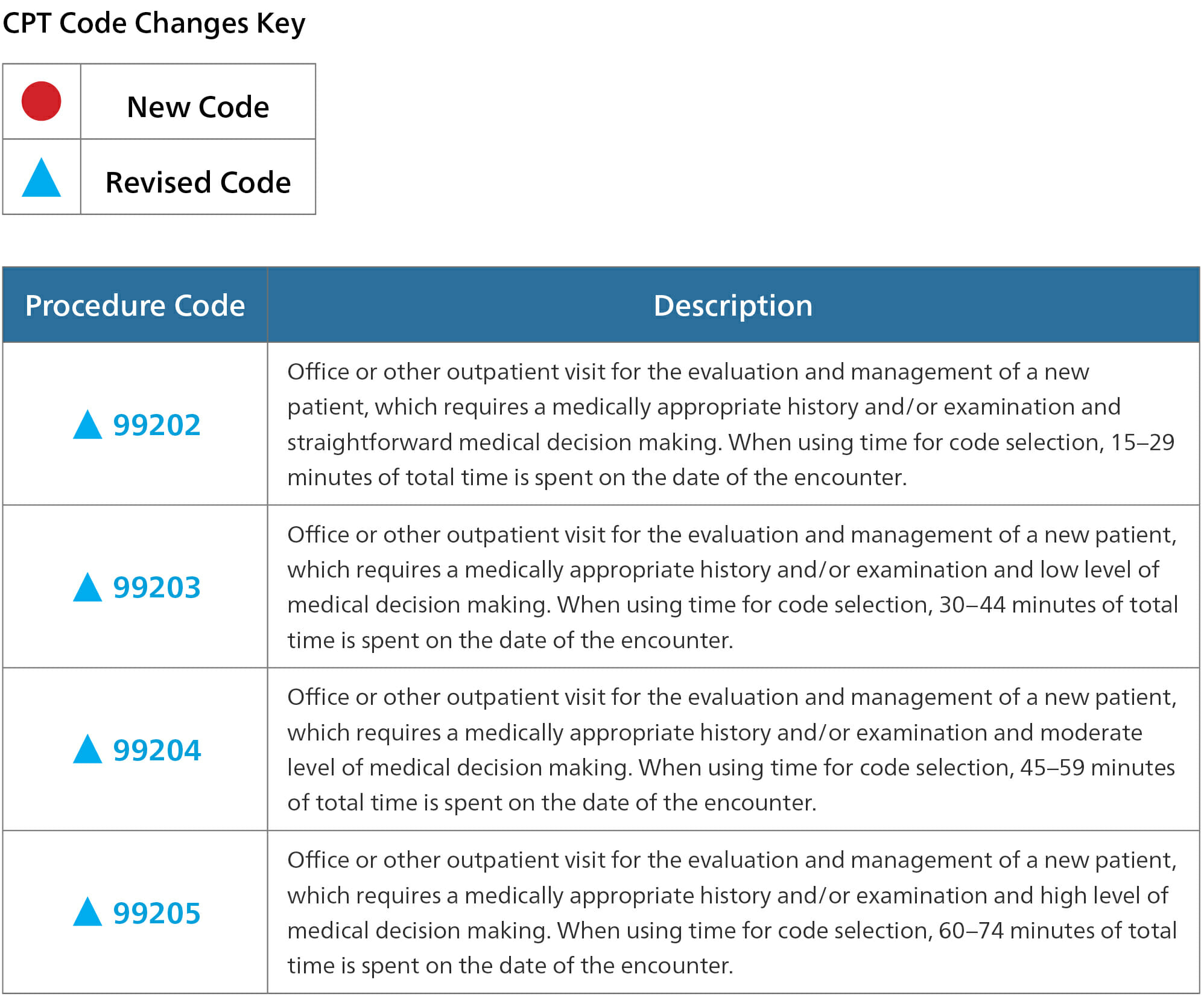
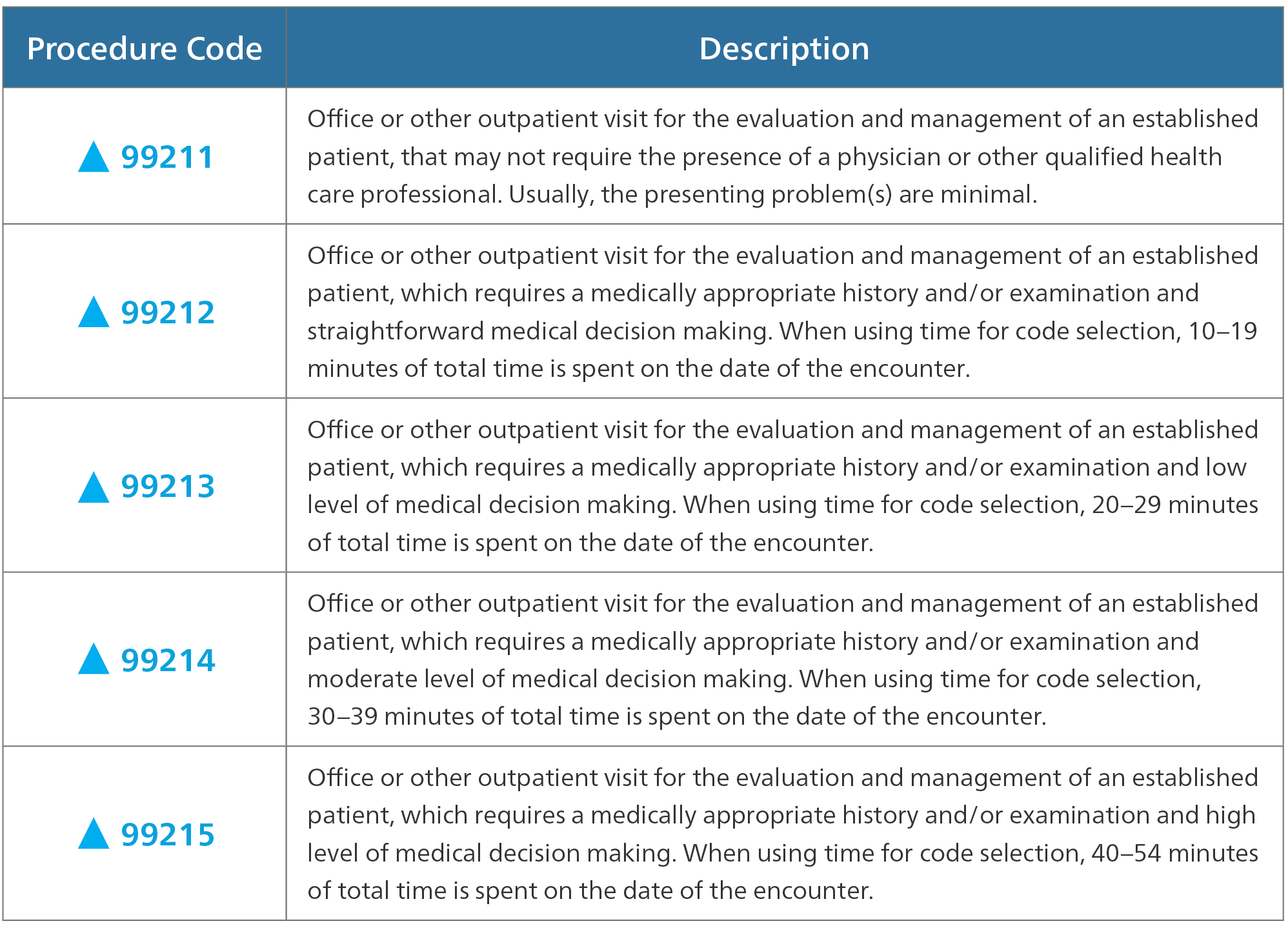
Medical Decision Making Changes
Though the workgroup did not materially change the three current MDM sub-components, they did provide extensive edits to code selection elements, revising and creating numerous clarifying definitions within the evaluation and management guidelines, as noted in the table below.

AMA CPT Medical Decision Making Table Changes
Before 2021, the MDM chart lacked specific criteria to determine a given complexity level for each element, necessitating the need for modifications of the MDM criteria. The panel used the current Medical Table of Risk as a foundation for designing the revised required elements for MDM, and reviewed existing CMS contractor audit tools to minimize disruption in MDM level criteria. The workgroup removed ambiguous terms (e.g., "mild") and defined previously vague concepts (e.g., "acute or chronic illness with systemic symptoms"). Additionally, the group defined new terms, such as "independent historian" and redefined data elements allow providers to focus on tasks that affect the patient's management (e.g., independent interpretation of a test performed by another provider and/or discussion of test interpretation with an external physician/QHP) instead of merely adding up tasks.
Table 1. MDM Complexity (pre-2021)

Note: The table above is still applicable for non-office or outpatient visit evaluation and management codes in 2021.
The AMA published a revised MDM table (Table 2) and enhanced guidelines in the 2021 CPT code manual, effective January 1, 2021. The additional detail added within the guidelines reduces variation in interpretation of existing MDM currently encountered across contractors and payors. As a part of the revision process, the panel reviewed the current CMS and contractor tables and audit to minimize coding patterns. The four MDM types (straightforward, low, moderate and high) were not changed, and MDM is still not applicable for Code 99211. By deleting CPT Code 99201, the AMA aligned the new patient evaluation and management office or other outpatient visit codes (99202–99205) with the established patient office or other outpatient visit codes (99211–99215), so that there are four levels of MDM for each.
Table 2. MDM Levels (Effective January 1, 2021)
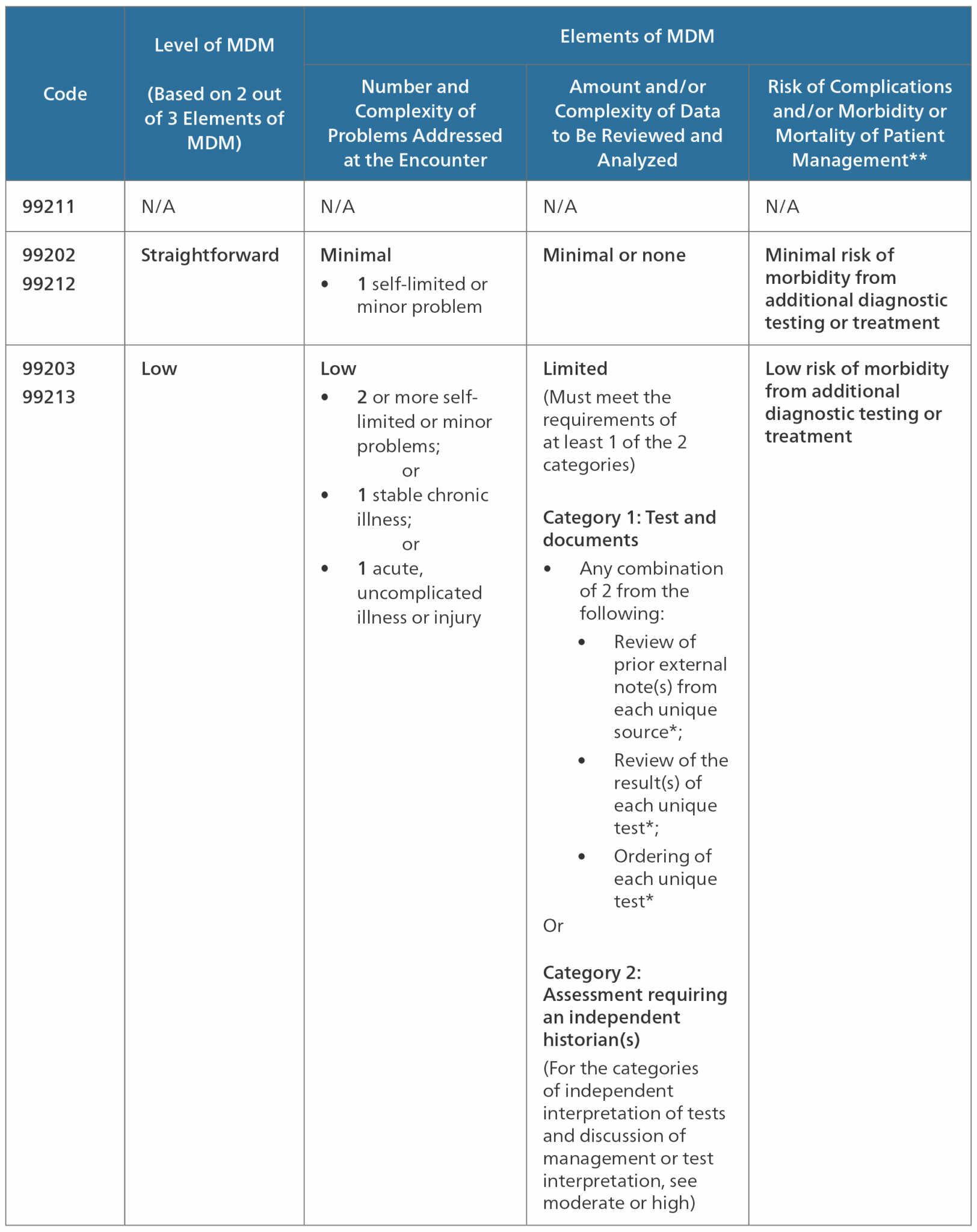
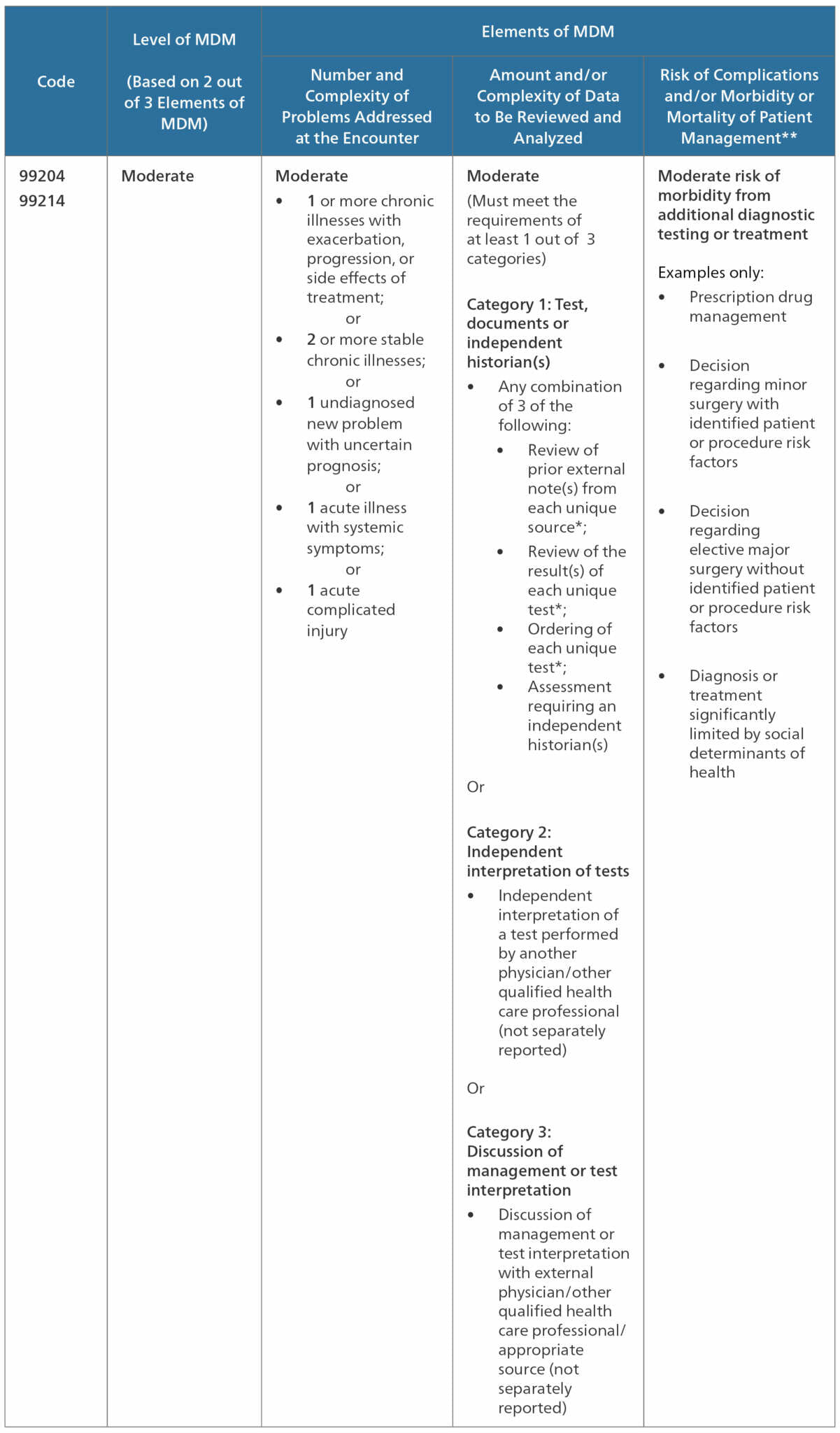
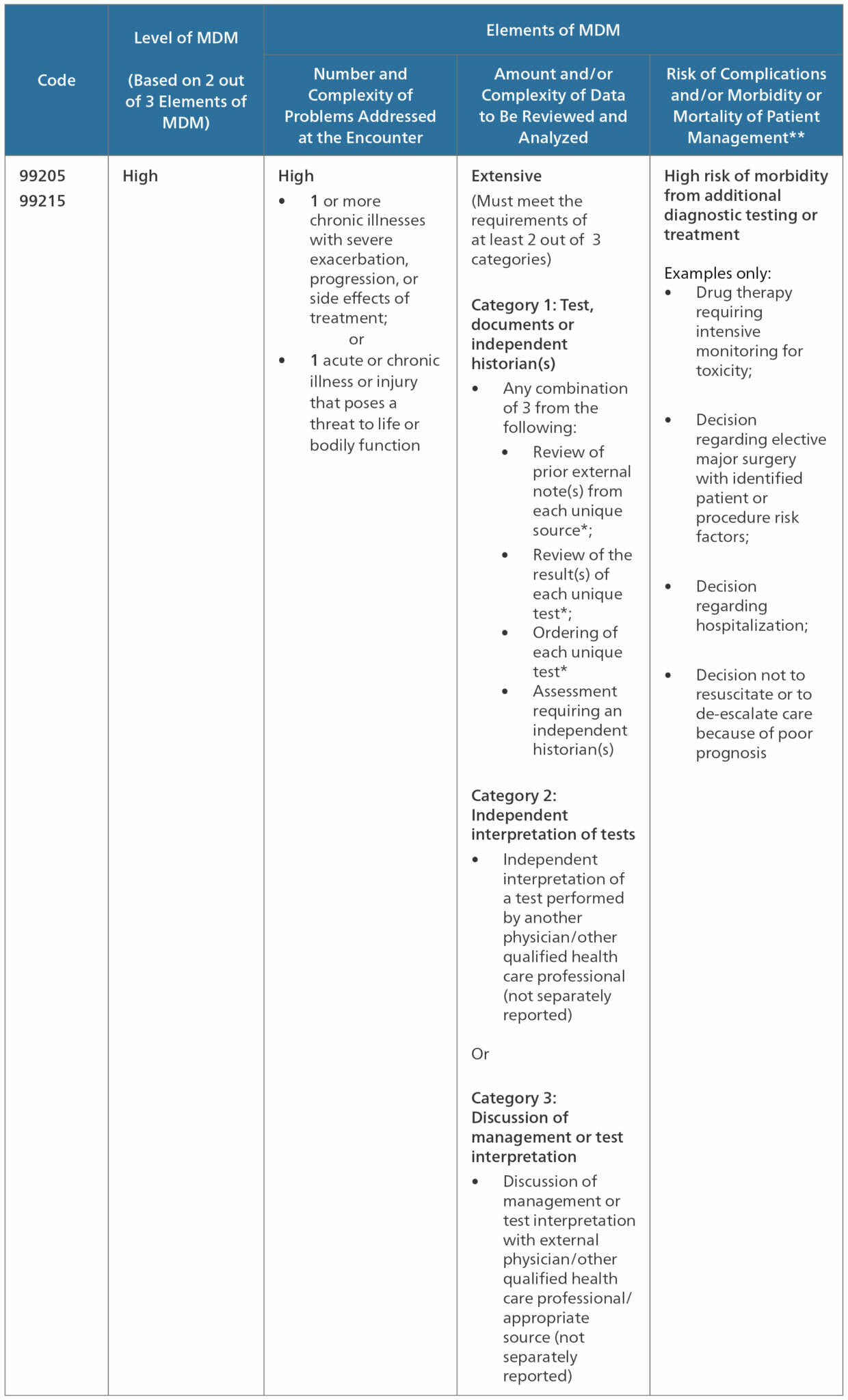
**When determining risk, the final diagnosis for a condition does not in itself determine the complexity or risk, as an extensive evaluation may infer that the signs or symptoms do not represent a highly morbid condition. Multiple problems of a lower severity may, in the aggregate, create a higher risk due to interactions.
Category 1 in Table 2 outlines subgroups for tests, documents and orders possibly performed for all MDM levels. For moderate and high MDM levels, the AMA included an additional subset for the option to assess a problem, illness or injury requiring an independent historian's participation. Together, these activities emphasize clinical work beyond just counting the number of documents reviewed. Clarification of key terms from this category from the CPT evaluation and management 2021 guidelines are shown in the table below.
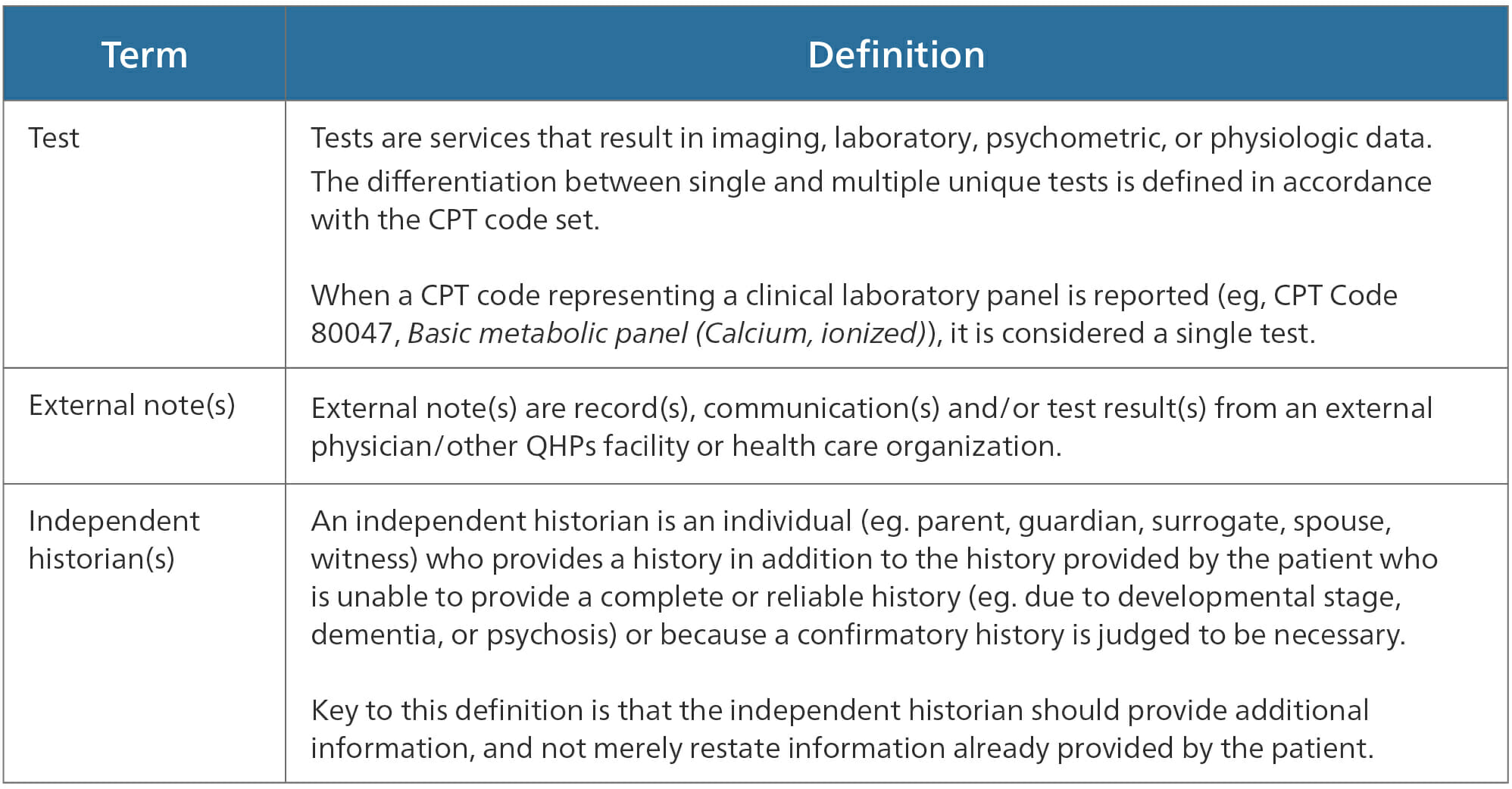
Each unique test, order or document contributes to the combination of two or three components in the Category 1 listing, with a minimum of activities performed in two different subgroups to fulfill the requirements for Category 1.
Time
As mentioned, the 2021 CPT code guidelines include a change that allows code selection based upon time. The AMA defines time as the minimum total time, not typical time, and represents the total physician/qualified health care professional's time on the date of service. The use of "date-of-service time" builds on Medicare’s movement over the last several years to better recognize the work involved in non-face-to-face services like care coordination. Of note, these definitions do apply if the code selection uses MDM as criteria. However, the provider must document the total time spent for the encounter. Note, time may be face-to-face or non-face-to-face, and must be performed on the same date of service. Additionally, note that time spent by the clinical staff does not count towards this time.
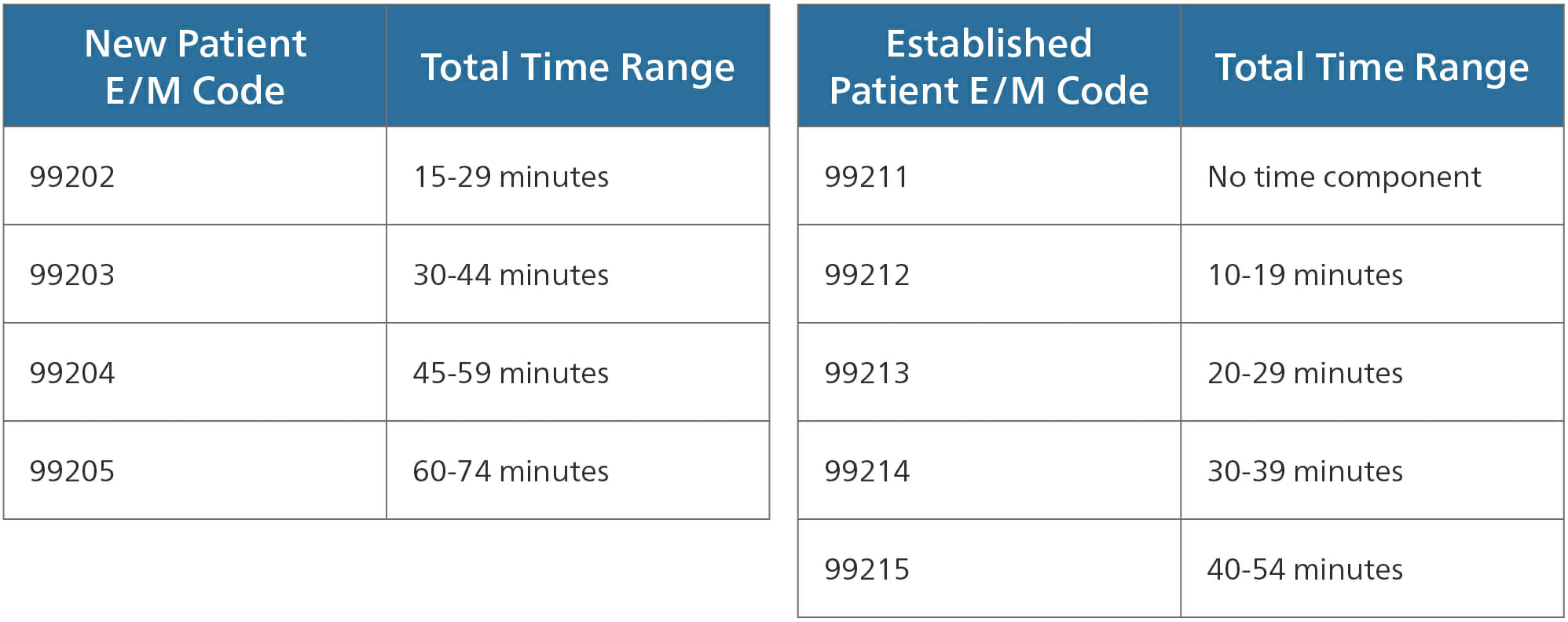
Prolonged Services
The concept of prolonged services, represented in Codes 99354–99355, no longer applies. The AMA removed procedure Codes 99202 thru 99215 from the parenthetical notes in the CPT 2021 manual. Nevertheless, the AMA introduced a new prolonged visit add-on code, 99417, to report additional time beyond the total time to use in conjunction with either Code 99205 or Code 99215. However, per the AMA guideline, the add-on code should only be reported when time is the basis for the code selection. Per the AMA, non-face-to-face prolonged services performed on a separate date of service should be reported with 99358 and 99359 accordingly.
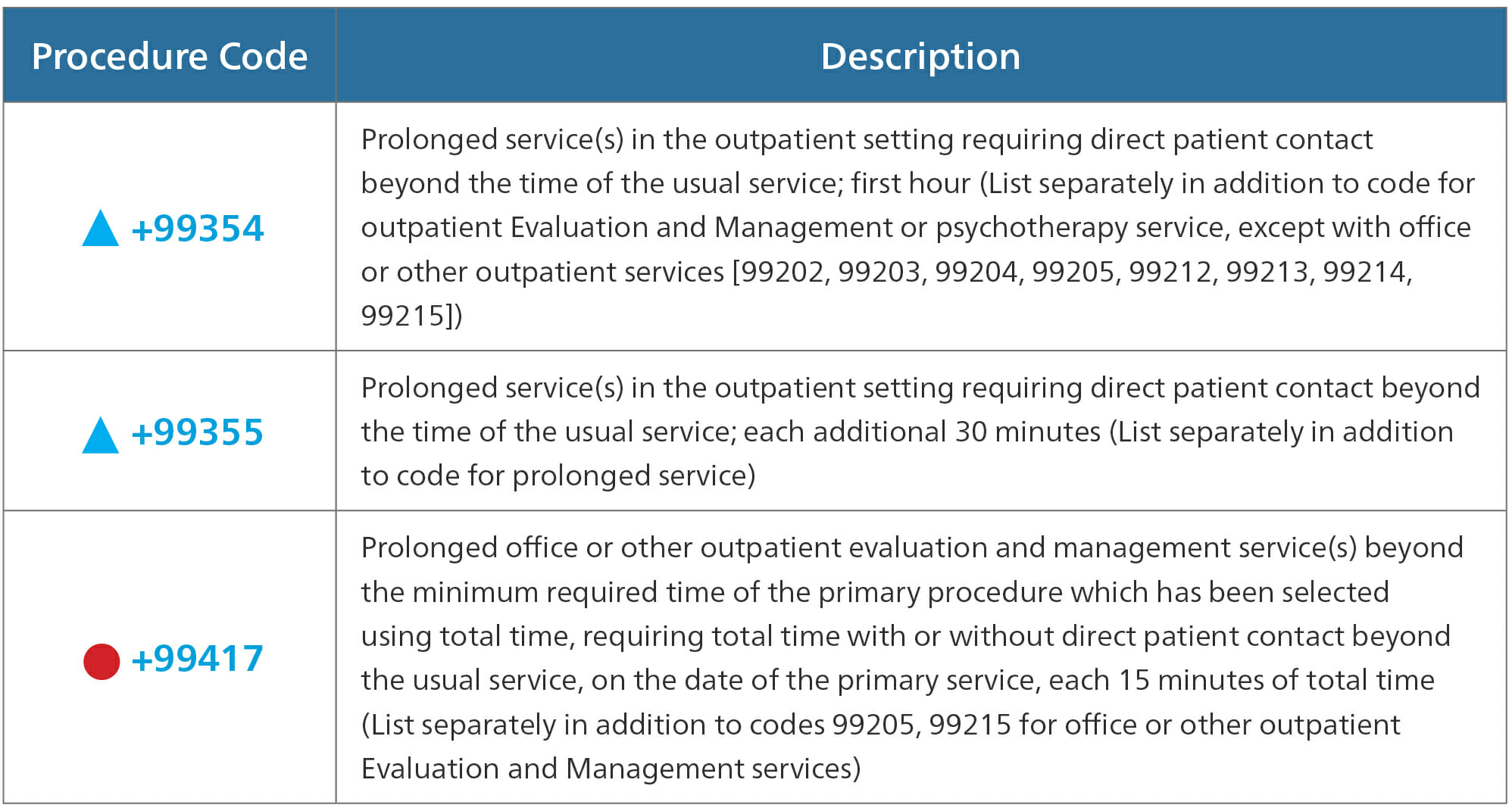 For reporting prolonged services for clinical staff, updated AMA guidelines instruct users to report Codes 99415 and 99416 in conjunction with the evaluation and management codes with total time, which is a change from 2020, repeating the theme of total time. These codes represent additional time spent by clinical staff requiring physician supervision beyond the upper limit of a time range. For example, if the physician reports CPT Code 99213—for which the total time range is 20–29 minutes—then they should report any time past the 29th minute spent by the clinical staff member using Codes 99415 or 99416. The time does not need to be continuous, but it needs to be on the same date of the encounter.
For reporting prolonged services for clinical staff, updated AMA guidelines instruct users to report Codes 99415 and 99416 in conjunction with the evaluation and management codes with total time, which is a change from 2020, repeating the theme of total time. These codes represent additional time spent by clinical staff requiring physician supervision beyond the upper limit of a time range. For example, if the physician reports CPT Code 99213—for which the total time range is 20–29 minutes—then they should report any time past the 29th minute spent by the clinical staff member using Codes 99415 or 99416. The time does not need to be continuous, but it needs to be on the same date of the encounter.
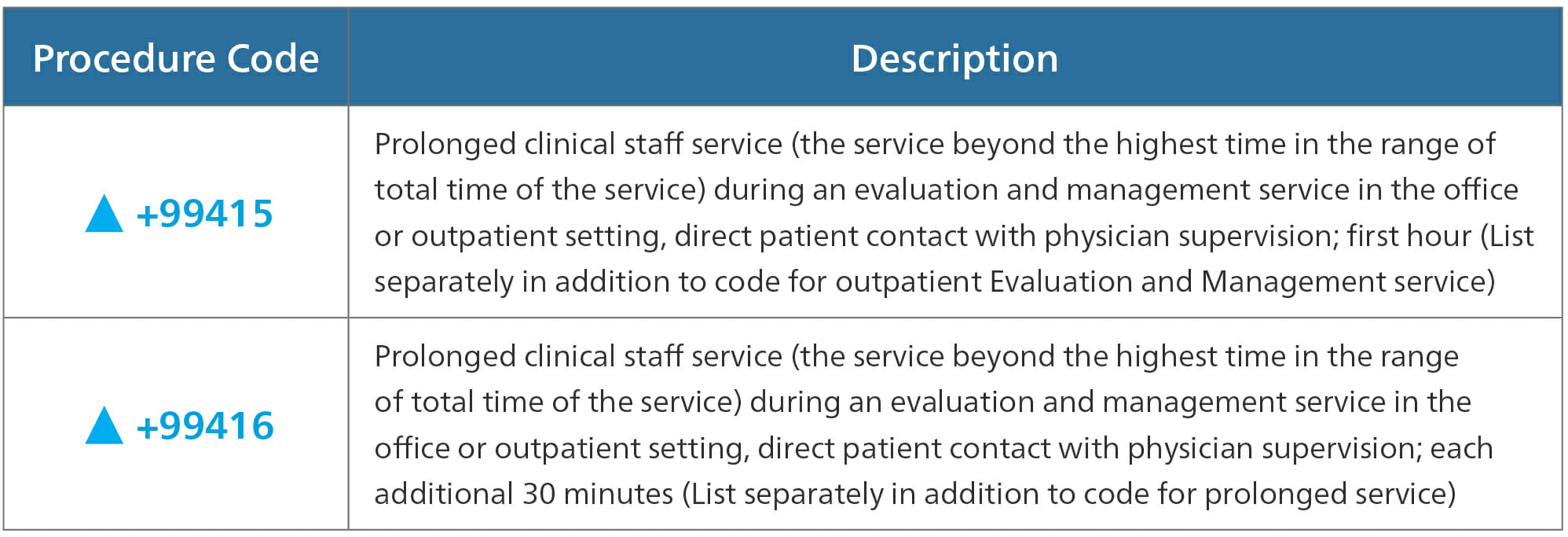
2021 CPT Code Updates: Summary
- History and Physical are no longer considered a key component, but now serve a "supporting role".
- The selection of a code is based on either MDM or Total Time Spent.
- The MDM criteria for Codes 99202–99215 is distinct from the prior model, which is still used for other evaluation and management services.
- Selection is based upon two of the three elements noted in Table 2.
- Total Time spent can include face-to-face and non-face-face time.
- Clinical staff time is not included in total time, but clinical staff prolonged services can be reported using add-on Codes 99415 and 99416.
- The service must meet two criteria to report a prolonged visit, Code 99417.
- Code selected using total time spent and;
- Primary code is either 99205 or 99215.
References
Amercian Medical Association. (2020, November). 2021 AMA CPT Symposium - E/M Changes Presentation. Chicago, IL, USA. American Medical Association. (2020). CPT | Changes 2021: An Insider's VIew. Chicago, IL, USA. American Medical Association. (2020). CPT 2021. Chicago, IL, USA. American Medical Association. (2020). E/M Office or Other Outpatient Guidelines and Code Revisions for 2021: MDM-Part 1. CPT Assistant May 2020, 2-9. American Medical Association. (2020). E/M Office or Other Outpatient Guidelines and Code Revisions for 2021: MDM-Part 2. CPT Assistant June 2020, 2-11. Della’Zanna, J. (2009, November 18). Understand how to apply the 1995 and 1997 Documentation Guidelines for E/M Services. Retrieved from Hcpro: https://www.hcpro.com/HIM-242234-8160/Understand-how-to-apply-the-1995-and-1997-Documentation-Guidelines-for-EM-Services.html#:~:text=For%20example%2C%20the%201995%20guidelines,system%20to%20attain%20each%20level.


